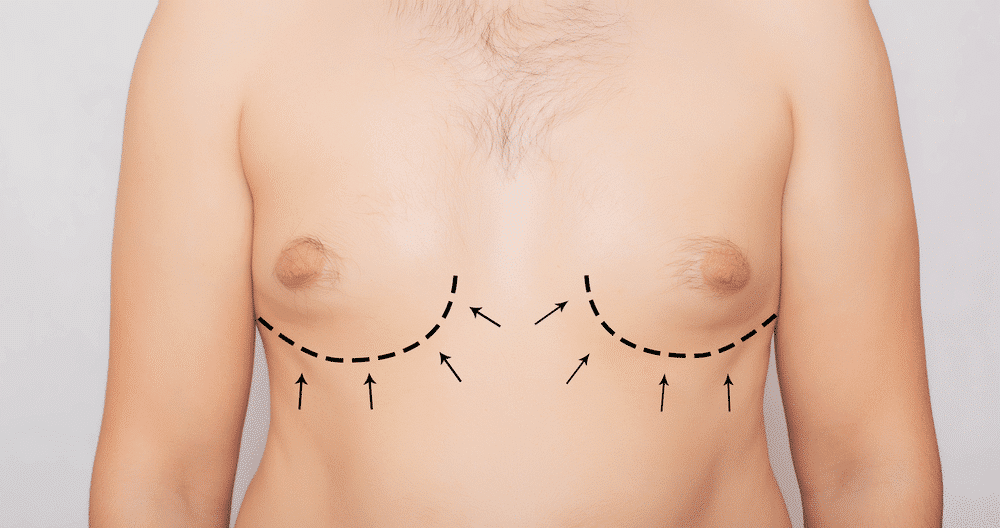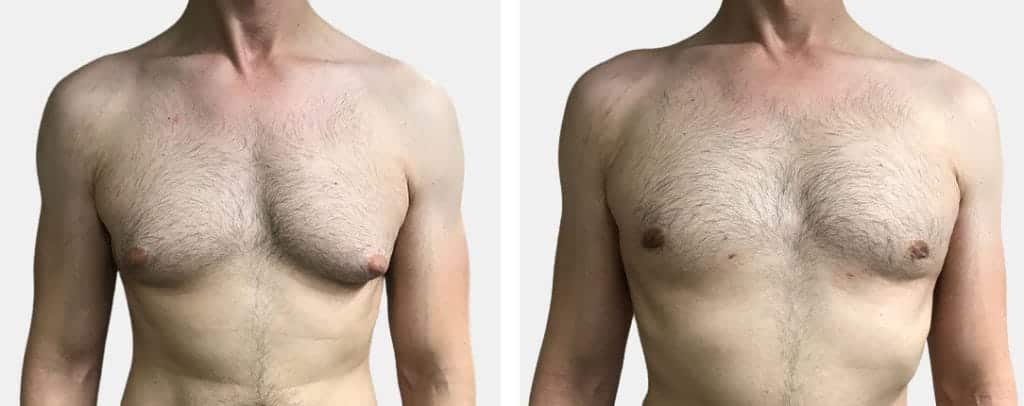Gynecomastia, the enlargement of male breast tissue, can be a source of embarrassment and discomfort for men in Pakistan. Fortunately, effective surgical options are available to restore a more masculine chest contour. This guide explores gynecomastia surgery options and recovery in Pakistan, providing you with the information you need to make informed decisions about your treatment.
Table of Contents
The prevalence of gynecomastia in Pakistan is not precisely documented, but anecdotal evidence suggests it’s a concern for many men. Several factors might contribute to this!
- Hormonal Imbalances: Fluctuations in testosterone and estrogen levels can trigger gynecomastia. Conditions like hypogonadism (low testosterone) or certain medications can disrupt this balance.
- Genetics: Some men are genetically predisposed to developing gynecomastia due to increased sensitivity to estrogen.
- Lifestyle: Obesity and certain medications can also contribute to gynecomastia development.
Treatment Options for Gynecomastia in Pakistan:
The surgical approach for gynecomastia depends on the severity of the condition and the underlying cause. Here’s an overview of the most common procedures performed in Pakistan:
1. Liposuction:
For men in Pakistan seeking to address gynecomastia, liposuction offers a minimally invasive solution for cases primarily involving excess fatty tissue enlargement. This technique utilizes a cannula, a thin tube inserted through small incisions, to suction out unwanted fat deposits from the chest area.
Liposuction boasts several advantages that make it an attractive option for many patients. Firstly, the minimally invasive nature of the procedure translates to minimal scarring. Compared to excision surgery, which involves direct tissue removal, liposuction leaves smaller, less noticeable marks. This is particularly beneficial for men concerned about aesthetics following surgery.
Secondly, liposuction offers a quicker recovery time. Since the procedure involves minimal tissue disruption, the body heals faster. This allows patients to return to their regular activities sooner, minimizing downtime and disruption to daily life.
Thirdly, liposuction is often the more cost-effective option compared to other gynecomastia surgical techniques. The minimally invasive nature of the procedure generally translates to lower overall costs associated with surgery and recovery.
However, it’s important to understand that liposuction isn’t a one-size-fits-all solution for gynecomastia. While it effectively addresses excess fat deposits, it has limitations. Liposuction might not be the most suitable option for men with:
- Significant Glandular Tissue Enlargement: If the primary concern is enlarged glandular tissue, liposuction alone might not be sufficient. The glandular tissue needs to be directly removed through excision surgery for a more definitive and sculpted chest contour.
- Loose Skin: In cases where significant skin laxity or stretching accompanies fatty tissue enlargement, liposuction alone might not provide optimal results. The loose skin might remain after fat removal, potentially requiring additional procedures like skin tightening to achieve a desirable aesthetic outcome.
Therefore, during the consultation, a qualified surgeon will carefully assess the extent of fatty tissue enlargement, skin elasticity, and the presence of glandular tissue. Based on this evaluation, they will determine whether liposuction is the most suitable approach or if a combination of liposuction and excision surgery is necessary for optimal results.

2. Excision:
For men in Pakistan with gynecomastia caused by enlarged glandular tissue, excision surgery offers a targeted approach to achieve a more defined chest contour. This technique involves the direct surgical removal of excess glandular tissue responsible for the appearance of enlarged breasts.
Excision provides a clear benefit: its ability to definitively address the underlying cause of gynecomastia. By directly excising the glandular tissue, the procedure effectively reduces the size and prominence of the chest, leading to a more masculine appearance. This can significantly improve self-confidence and overall well-being for men struggling with gynecomastia.
However, it’s important to consider the trade-offs associated with excision surgery. Compared to liposuction, excision typically involves a more extensive procedure with potentially longer recovery times. Additionally, due to the nature of tissue removal, excision might leave more noticeable scars. While advancements in surgical techniques minimize scarring, some degree of marking is inevitable.
The cost of excision surgery is also generally higher compared to liposuction. This is due to the increased complexity of the procedure and potentially longer operating time.
Therefore, the decision to undergo excision surgery is best made in consultation with a qualified surgeon. They will assess the severity of gynecomastia, the presence of fatty tissue, and skin elasticity. In many cases, particularly for men with both glandular tissue enlargement and excess fat, a combination of liposuction and excision surgery might be the most effective approach. This combination offers the benefits of both techniques, effectively removing glandular tissue while simultaneously addressing fatty deposits for a sculpted and natural-looking chest.

3. Combination Surgery (Liposuction and Excision):
For many men in Pakistan seeking to address gynecomastia, combination surgery emerges as the most effective solution. This procedure combines the benefits of liposuction and excision surgery, offering a comprehensive approach to tackle both fatty tissue enlargement and excess glandular tissue.
Liposuction, as discussed earlier, effectively removes unwanted fat deposits from the chest using a minimally invasive technique. Excision surgery, on the other hand, directly targets and removes the underlying glandular tissue responsible for the appearance of enlarged breasts. By combining these techniques, combination surgery provides a more definitive and sculpted chest contour, addressing both aspects of gynecomastia for a more masculine appearance.
This comprehensive approach offers several advantages. Firstly, it tackles both the root cause (glandular tissue) and the visible symptom (fatty tissue) of gynecomastia. This ensures a more dramatic and long-lasting improvement in chest appearance. Secondly, by addressing both fat and glandular tissue, combination surgery can achieve a more natural-looking chest contour compared to relying on one technique alone.
However, it’s important to acknowledge the considerations associated with combination surgery. The procedure is generally more extensive compared to liposuction or excision alone. This translates to a longer operating time, potentially leading to a longer recovery period. Additionally, due to the involvement of both liposuction and tissue removal, combination surgery might leave more noticeable scars. While advancements in surgical techniques minimize scarring, some degree of marking is likely.
Finally, the cost of combination surgery is generally the highest among the three procedures discussed. This is due to the increased complexity of the procedure, longer operating time, and potentially additional resources required.
Therefore, the decision to undergo combination surgery requires careful discussion with a qualified surgeon. They will assess the specific characteristics of your gynecomastia, including the extent of fatty tissue and glandular tissue enlargement, skin elasticity, and your overall health. Based on this comprehensive evaluation, the surgeon will determine if combination surgery is the most suitable approach to achieve your desired outcome.
Choosing the Right Gynecomastia Surgeon in Pakistan:
Selecting a qualified and experienced surgeon is crucial for a successful outcome. Here are some factors to consider when choosing a gynecomastia surgeon in Pakistan:
- Board Certification: Ensure your surgeon is certified by the College of Physicians and Surgeons of Pakistan (CPSP).
- Experience: Choose a surgeon with a proven track record of successful gynecomastia surgeries. Look for surgeons specializing in cosmetic surgery or plastic surgery.
- Hospital Affiliation: Opt for surgery performed in a reputable, accredited hospital with advanced facilities for patient care.
- Consultation: During the consultation, discuss your expectations, medical history, and any concerns you have.
Considering Gynecomastia Correction in Lahore? Dr. Atta Plastic Surgeon, a board-certified plastic surgeon in Lahore, offers consultations for gynecomastia correction. With years of experience and specializes in various cosmetic procedures, including gynecomastia surgery!
Recovery after Gynecomastia Surgery in Pakistan:
The journey to recovery after gynecomastia surgery in Pakistan requires dedication and patience. Here’s what to expect:
- Managing Discomfort: Post-operative pain is a normal sensation following surgery. Fortunately, medications prescribed by your surgeon can effectively manage discomfort.
- Swelling and Bruising: Swelling and bruising around the chest area are also common after surgery. These are temporary and typically subside within a few days to weeks. Applying ice packs and maintaining proper elevation of the chest can help minimize swelling.
- Compression Garment Support: Wearing a compression garment following surgery is crucial. This specialized garment applies gentle pressure to the treated area, helping to reduce swelling, promote healing, and support the new chest contour. Your surgeon will provide specific instructions on how long to wear the garment.
- Limiting Physical Activity: Strenuous physical activity initially needs to be restricted to allow the body to heal properly. Your surgeon will advise you on a specific timeframe for resuming exercise and gradually increasing activity levels.
- Regular Follow-up Appointments: Maintaining regular follow-up appointments with your surgeon is vital. These visits allow them to monitor your recovery progress, address any concerns you might have, and ensure everything is healing as expected.
You may maximize your healing and get the best result from gynecomastia surgery by following these recovery rules and your surgeon’s advice. Always keep in mind that the secret to a successful and seamless healing process is maintaining open contact with your surgeon.
Important Considerations Regarding Gynecomastia Surgery in Pakistan:
Gynecomastia can be treated with 90,000 to 200,000 cost range in Pakistan. However the variation in the cost can be dependent on the kind of care that is needed.
It’s very imprortent to maintain realistic expectations about the outcome. While surgery can significantly improve chest contour, it won’t create a perfectly sculpted physique. Discuss desired outcomes with your surgeon during the consultation. Maintaining a healthy weight and lifestyle after surgery can help prevent recurrence.
Overall, For Pakistani men looking to enhance their quality of daily life and restore confidence, gynecomastia surgery can be a transformative experience. Gaining a more manly chest contour and feeling better about yourself can be accomplished by being aware of your alternatives for surgery, selecting a skilled surgeon, and adhering to the recommended recuperation guidelines.

